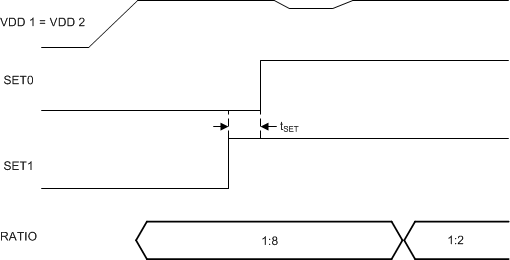JAJSFU1A July 2018 – September 2021 TPS3430-Q1
PRODUCTION DATA
- 1 特長
- 2 アプリケーション
- 3 概要
- 4 Revision History
- 5 Pin Configuration and Functions
- 6 Specifications
- 7 Detailed Description
- 8 Application and Implementation
- 9 Power Supply Recommendations
- 10Layout
- 11Device and Documentation Support
- 12Mechanical, Packaging, and Orderable Information
7.3.2.1.3 SET0 and SET1 During Normal Watchdog Operation
The SET0 and SET1 pins can be used to control the window watchdog ratio of the lower boundary to the upper boundary. There are four possible modes for the watchdog (see Table 8-7): disabled, 1:8 ratio, 3:4 ratio, and 1:2 ratio. If SET0 = 1 and SET1 = 0, then the watchdog is disabled. When the watchdog is disabled WDO does not assert, and the TPS3430-Q1 ignores all inputs to WDI. The SET0 and SET1 pins can be changed when the device is operational, but cannot be changed at the same time. If these pins are changed when the device is operational, then there must be a 500-µs (tSET) delay between switching the two pins. If the SET0 and SET1 are used to change the reset timing, then a reset event must occur before the new timing condition is latched. This reset can be triggered by bringing VDD below VUVLO. Figure 7-4 shows how the SET0 and SET1 pins do not change the watchdog timing option until a reset event has occurred.
 Figure 7-4 Changing SET0 and SET1 Pins
Figure 7-4 Changing SET0 and SET1 Pins